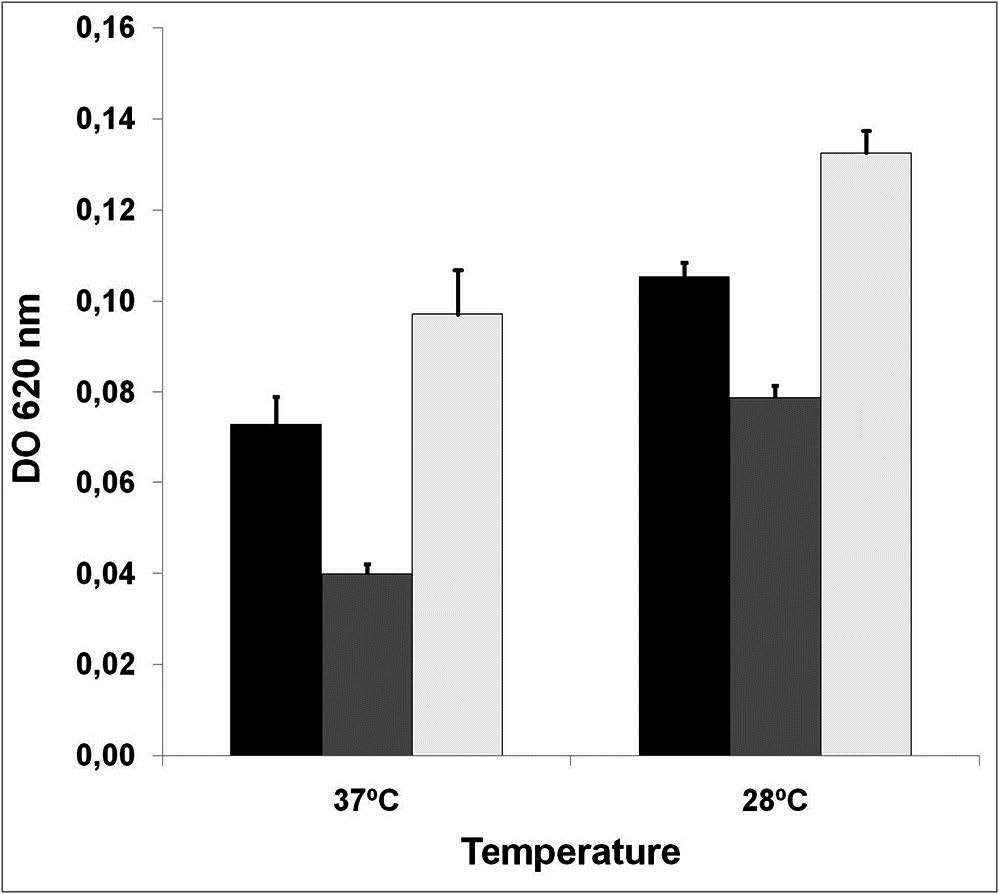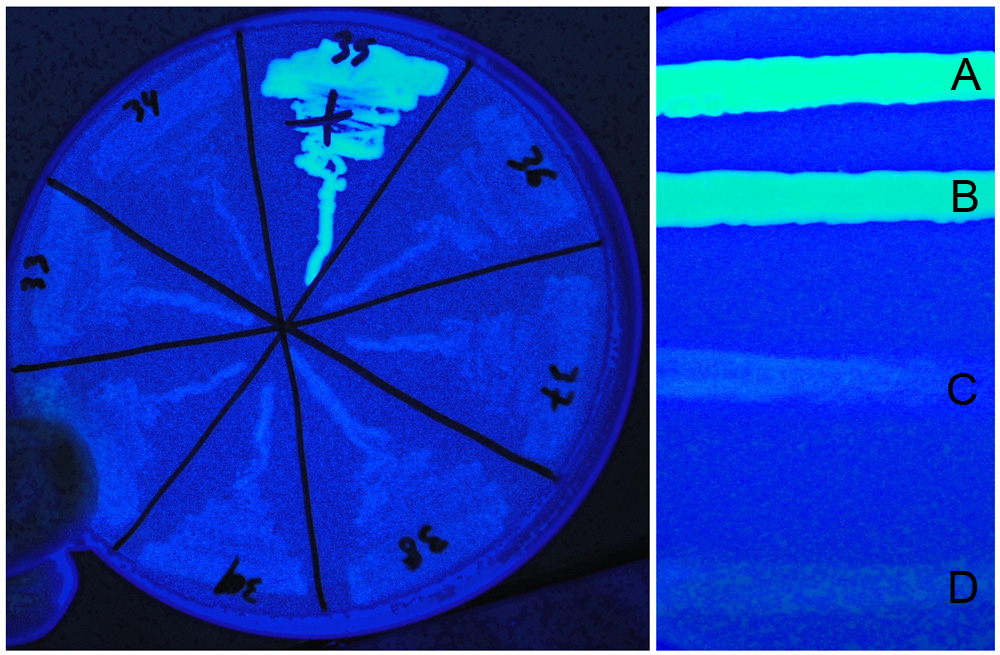1. Introduction
Hafnia alvei is a Gram-negative facultatively anaerobic bacillus that belongs to the family Enterobacteriaceae. It is known to be among the Enterobacteriaceaespecies most commonly isolated from vacuum-packed chilled meat samples, raw milk, raw fish and other foods [1,2,3]. H. alvei is also an opportunistic human pathogen involved in various types of nosocomical infections [4,5,6,7]. Though H. alvei isolation from human clinical specimens remains uncommon, development of drug resistance by this species is emerging and it is likely that this organism will gain increasing importance in the future [8]. Moreover, these bacteria have been considered as opportunistic pathogens in several animal species including mammals, fish, insects and birds [4,9,10]. Although some virulence traits have been studied in H. alvei, little is known about the factors that contribute to their pathogenesis within a host, including biofilm formation [11,12,13]. Biofilms can be defined as a structured community of bacterial cells enclosed in a self-produced polymeric matrix and adherent to an inert or living surface. Growth in biofilm enables bacterial populations to survive better in hospital environments, food-processing environments and during host infections, increasing the probability of causing infections. In addition, some antiseptics and disinfectants extensively used in hospitals are ineffective against pathogens growing as biofilms attached to surfaces [14]. Furthermore, biofilm formation has been connected to infections associated with indwelling medical devices, such as central venous or urinary catheters [15]. We recently used the next generation sequencing (NGS) technologies to obtain the complete genome sequence of H. alvei HUMV-5920 isolated from the urine sample from a human patient [16]. The goal of the present study was to analyze the capacity of an H. alvei HUMV-5920 human isolate to form biofilms. Our results confirmed the presence of genes already described for the modulation of multicellular behavior in Salmonella Typhimurium and other Enterobacteriaceae species, but also revealed new aspects of the biofilm formation process. This should contribute to a better understanding of the correlation between adherence capabilities and the pathogenicity of this bacterium.
2. Materials and Methods
2.1. Bacterial strains
The strain used in this study (HUMV-5920) was isolated from the urine sample from a woman at the Hospital Universitario Marqués de Valdecilla in Santander, Spain [16]. The strain was routinely cultured in Luria-Bertani (LB) agar or broth and frozen at -80 °C with 20% glycerol. Strains Salmonella Enteritidis 3934 with rdar, bdar, pdar and saw morphotypes (kindly provided by Dr. Toledo-Arana) were used as positive controls for the different phenotypes.
2.2. Growth conditions and morphotype identification
Hafnia alvei was directly streaked on Congo Red (CR) plates, which are LB plates without salt supplemented with CR (40 µg/ml) and Coomassie brilliant blue (20 µg/ml). Colony morphology was assessed on CR plates after growth at 37 °C for 24 h and at 28 °C for 48 h according to the basic morphotypes detected in S. Enteritidis 3934: rdar (expresses curli fimbriae and cellulose), pdar (expresses cellulose), bdar (expresses curli fimbriae) and saw (no expression of curli fimbriae nor cellulose) [17,18]. Indication for cellulose production was obtained when fluorescent colonies were observed under a 366-nm UV light source after growth on calcofluor (fluorescent brightener) plates (LB agar plates with 50 µM calcofluor).
2.3. Biofilm formation
Biofilm formation was estimated in 48-well Ubottom polystyrene microtiter plates (Nunc, Thermo Fisher Scientific) by the method of O’Toole and Kolter with some modifications [19]. H. alvei was grown in LB medium for 24 h at 37 °C with shaking (175 rpm), and a 1:1,000 dilution was prepared in PBS (OD620, 0.01). Twenty-five microliters were placed in each well containing 500 µl of culture medium. The microplates were incubated under static conditions for 48 h at 28 °C or 37 °C. Wells containing biofilms were rinsed three times with distilled water (1 ml/well), and stained with 1ml/well of crystal violet (CV) (0.7% [wt/vol] solution; Sigma-Aldrich) for 12 min. Excess stain was removed by three washes with distilled water. Crystal violet was extracted by an ethanol-acetone solution (80:20, vol/vol), and the plates were incubated at RT in an orbital shaker for 1 min at 400 rpm (Thermomixer comfort; Eppendorf) to release the dye into the solution. Then, a sample of 100 µl from each well was transferred to another 96-well flat-bottom plate, and the amount of dye (proportional to the density of adherent cells) was determined at 620 nm using a microplate reader (Multiskan FC; Thermo Fisher). In each experiment, results were corrected for background staining by subtracting the value for crystal violet bound to uninoculated controls. The biofilm assay was performed three times, with duplicates in each assay. To confirm the role of cellulose in the biofilm formation process of the wild-type strain H. alvei HUMV-5920, the biofilm-forming assay was carried out in the presence of 0.1% cellulase (Sigma) as described elsewhere [20]. Biofilm formation was studied also using Tryptic Soy Broth (TSB) and Brain Heart Infusion Broth (BHIB) as culture media.
2.4. Confocal Laser Scanning Microscopy (CLSM)
Bacteria were grown in 4-well μ-chamber uncoated slides (Ibidi, Martinsried) without shaking, in presence or absence of 0.1% cellulase (Sigma). The slides were incubated at 37 °C for 48 h. After 48 h, planktonic cells were removed by rinsing with saline (0.85% NaCl) and bacterial viability within biofilms in chambers with or without cellulose was determined by adding 200 ml of the BacLight LIVE/DEAD bacterial viability kit (Molecular Probes Inc.) per well for 25 min. For LIVE/DEAD a 488/561 nm excitation, 500-550/570-620 nm emission filters were used respectively. A series of optical sections were obtained with a Nikon A1R confocal scanning laser microscope. Images were captured at random with a ×20 Plan Apo 0.75 NA objective. Reconstructions of confocal sections were assembled using the NIS-Elements 3.2 software. Z-stacks of confocal images were rendered into 3D mode using the ImageJ software.
2.5. Sequence analysis of cellulose biosynthesis genes
Genome-wide comparative and interspecies clustering analyses of protein coding sequences (CDSs) related to cellulose production were performed using a new version of the Conserved Domain Database (CDD) Version 3.15 and UGENE Version 1.24.
3. Results
Hafnia alvei strain HUMV-5920 was able to form biofilms in microtiter plates and glass. The amount of biofilm formed in LB or in TSB medium was higher than that of cells grown in BHIB (Figure 1). Interestingly, 28 °C was the most favorable temperature to form biofilms in all culture media under static conditions in comparison with 37 °C.
Calcofluor binding assays indicate putative production of cellulose in this strain (Figure 2).
Since calcofluor binding is not absolutely specific for cellulose (a 1,4-β-glucan), we confirmed cellulose production by an enzymatic assay. The presence of cellulase in the media during the biofilm formation process in H. alvei led to a total absence of a visible biofilm in LB medium without salts (Figure 3).
Similar results were obtained after staining of Hafnia alvei and Salmonella biofilms and processed by CLSM. Our findings also showed that bacterial attachment and biofilm formation can be greatly prevented by cellulase treatment in H. alvei as well as in the rdar morphotype of S. Enteritidis (expresses curli fimbriae and cellulose), whereas pdar (expresses only cellulose) and bdar (expresses only curli fimbriae) were less affected. The saw morphotype (no expression of curli fimbriae nor cellulose) was not significantly affected. Representative CLSM images are shown in Figure 4.
Genome-wide comparative and interspecies clustering analyses of CDSs related to cellulose production were performed with E. coli and Salmonella enterica, yielding interesting information. The basic structural genomic organization of the cellulose biosynthesis system present on both reference species (operons bcsABZC and bcsEFG) is also present in the H. alvei HUMV-5920 chromosome (Figure 5).
4. Conclusion
The ability of opportunistic pathogens to form biofilms is of significant clinical interest, since biofilm formation influences the efficacy of antimicrobial therapy and the outcome of an infection. Moreover, biofilm formation may contribute to the establishment and long-term survival of bacterial pathogens in the hospital environment or in food processing environments [21]. A number of previous studies have shown that the nutrient content of the growth medium influences biofilm development in different organisms. More specifically, environmental factors such as glucose and temperature affect biofilm development in Enterobacteriaceae and other bacteria [22,23]. In this line, we have shown that environmental factors such as temperature affect biofilm development in H. alvei [12,13]. In agreement with our previous reports, low temperature induces high biofilm formation in strain HUMV-5920.
A four-gene bcsABCD operon involved in cellulose biosynthesis was initially identified in Acetobacter xylinus. An early analysis of the cellulose synthase operons in E. coli and S. enterica indicated the presence of the same bcsA, bcsB, and bcsC genes and two additional genes, yhjQ and bcsZ conforming a new variant, the bcsABZC operon. This locus also contains a divergent operon, bcsEFG, which is also required for cellulose production [24]. All the four proteins in the bcsABZC operon were required for maximal cellulose production in vivo with BcsC involved in exporting the glucan molecules and packing them at the cell surface [24], and all these genes are present in the H. alvei HUMV-5920 chromosome [16]. The production of an extracellular matrix is recognized as a key element in determining the mature biofilm architecture [25,26]. Cellulose production prepares bacteria for surface colonization because it has a high capacity of water retention, mediates cell-cell interactions and cell adherence [27].
To date, only two other H. alvei genomes have been fully sequenced: strain FB1, from a kind of fish food in Asia [28] and strain FDAARGOS-158 (GenBank sequence CP014031.1) from stool. Our genomic analysis also suggests a high frequency of putative adhesins and toxins produced by Hafnia isolates and also several genes implicated in antimicrobial resistance such as metallo-and beta-lactamases, multidrug export proteins and efflux pumps, and penicillin-binding proteins (PBPs) [16]. The genotypic and phenotypic characteristics of Hafnia alvei strains, in particular our clinical isolate, could reflect the organism’s ability to sense and adapt to changes in its environment. Moreover, the genomics of this strain will accelerate research on H. alvei in numerous domains and will provide new insights into the genetic mechanisms responsible for the virulence in this species. These data and recent preoccupant findings on antimicrobial resistance in Hafnia strains [8] claim for further efforts to examine the precise significance of Hafnia strains in the clinical settings.
Acknowledgements
J.R.-V. holds a Miguel Servet II contract from the Instituto de Salud Carlos III, Spain. M.L.-D. holds a contract from the Instituto de Investigación Sanitaria Valdecilla IDIVAL and Universidad de Cantabria (no. PREVAL16/05). S.R.-S. holds a contract from the Instituto de Investigación Sanitaria Valdecilla IDIVAL.
Conflict of Interest
All authors declare no conflicts of interest in this paper.










 DownLoad:
DownLoad: 











